Lea Wait's Blog, page 25
December 1, 2024
December on a Maine Christmas Tree Farm
 Kaitlyn Dunnett/Kathy Lynn Emerson here, today with an updated version of a post that first ran way back on December 2, 2011. At the time, one of my husband’s two retirement businesses was a cut-your-own Christmas tree farm. We were open for eight years and probably would have continued to grow and sell our trees longer if it hadn’t been for escalating liability insurance rates and the fact that we were starting to slow down as we entered our seventies. Since it’s that time of year again, here’s a look back. Enjoy!
Kaitlyn Dunnett/Kathy Lynn Emerson here, today with an updated version of a post that first ran way back on December 2, 2011. At the time, one of my husband’s two retirement businesses was a cut-your-own Christmas tree farm. We were open for eight years and probably would have continued to grow and sell our trees longer if it hadn’t been for escalating liability insurance rates and the fact that we were starting to slow down as we entered our seventies. Since it’s that time of year again, here’s a look back. Enjoy!
December on a Maine Christmas Tree Farm
During the month of December, I don’t get much writing done. ‘Tis the season, which in our case means Christmas tree season. My husband and I run an organic cut-your-own Christmas tree farm.

they start at $45 these days
A decade before he retired, he decided to plant balsam fir trees on part of our twenty-five acre lot in the Mystic Valley. You probably won’t find Mystic Valley on a map, but it runs along U. S. Rt. 2 between Wilton and Dixfield and we’re right in the middle of it.

baby trees in foreground
Growing Christmas trees is a ten-year plan in the truest sense, because it takes ten years for one to grow big enough to sell. Two years ago, our first crop was ready. At the same time, my third mystery in the Liss MacCrimmon series, A Wee Christmas Homicide was published. It had a nice Christmas tree on the cover. It seemed only natural to open up my box of author copies and offer a free autographed book to the first twenty-five customers to purchase a tree. We also lured folks in with complimentary hot cocoa and candy canes.

That first year, we curtained off the front of one side of the garage and called it our “gift shop,” offering the books, the treats, and an assortment of the handcrafted wooden objects my husband makes in his post-retirement second career as a custom woodworker, everything from battery-operated clocks and decorative little keepsake boxes to cradles and chessboards. We had a good season, but it was darned cold in that gift shop. The second year, we smartened up and curtained off the front half of my husband’s heated workshop instead. The inventory expanded, too, since he had begun to specialize in two specific wooden items, magic wands and cat-and-child-proof jigsaw-puzzle tables. We also began to sell another local product, produced by neighbors in the village of East Dixfield, Mystic Valley Maples—real Maine maple syrup.

Of course we mostly sell Christmas trees. Our entire season lasts less than a month, from the Saturday after Thanksgiving until the Sunday before Christmas. Hours are daily 10 A.M. until 4 P.M. or it’s too dark to see (There are no lights out in the fields).
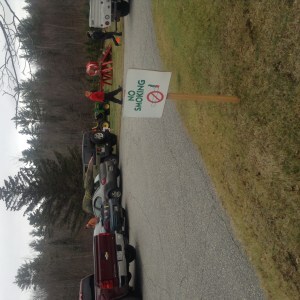
good thing we have a big dooryard for customers to park in
There’s a lot of setting up to do besides the shop. There’s the motion sensor attached to a buzzer to alert us when a vehicle pulls into the dooryard. There’s a hand-cranked netting machine, to make it possible for the tree to actually fit into the trunk of a car or the back of a truck. There are signs to put up, both informative (cash or checks only; no credit cards) and to keep little kids from falling into Moosetookalook Pond, which isn’t yet frozen solid. It measures a whole six feet in diameter at its widest point but it’s deep enough to be dangerous to small fry.

My husband swears it isn’t why he grew his beard when he retired, but he does now bear a certain resemblance to jolly old St. Nick, especially when he comes out to greet customers wearing a red sweatshirt and a Santa Claus hat. I wear a green sweatshirt with Christmas trees on it. I pretty much stay in the gift shop to write the receipts and collect the money. Did I mention that it’s cold outside? I do venture out when our favorite type of customer shows up—parents taking their children to cut down a Christmas tree for the very first time. I wish I could bottle that excitement. Little kids get a real kick out of picking out the tree, helping to cut it down, and dragging it back in on a tarp. We let them run the netter, too.
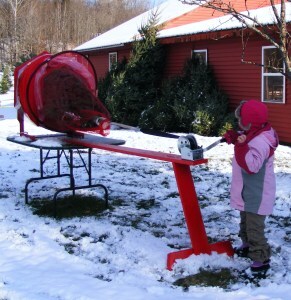
When we shut down just before Christmas, the season is over for another year, except, of course, for the next round of planting, pruning, and mowing between the rows. The husband does all that. I go back into my office to write more books.
Author’s note: One of those books was a second Christmas mystery in the Liss MacCrimmon series, Ho-Ho-Homicide. It should come as no surprise that it is set on a Christmas tree farm. This blog was also reprinted in I Kill People for a Living: A Collection of Essays by a Writer of Cozy Mysteries (2021).
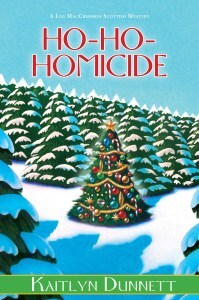
Kathy Lynn Emerson/Kaitlyn Dunnett has had sixty-four books traditionally published and has self published others. She won the Agatha Award and was an Anthony and Macavity finalist for best mystery nonfiction of 2008 for How to Write Killer Historical Mysteries and was an Agatha Award finalist in 2015 in the best mystery short story category. In 2023 she won the Lea Wait Award for “excellence and achievement” from the Maine Writers and Publishers Alliance. She was the Malice Domestic Guest of Honor in 2014. She is currently working on creating new editions of her backlist titles. Her website is www.KathyLynnEmerson.com.
November 29, 2024
Weekend Update: November 30-December 1, 2024
 Next week at Maine Crime Writers there will be posts by Kaitlyn Dunnett/Kathy Lynn Emerson (Monday), Kate Flora (Tuesday), Brenda Buchanan (Thursday) and John Clark (Friday).
Next week at Maine Crime Writers there will be posts by Kaitlyn Dunnett/Kathy Lynn Emerson (Monday), Kate Flora (Tuesday), Brenda Buchanan (Thursday) and John Clark (Friday).
In the news department, here’s what’s happening with some of us who blog regularly at Maine Crime Writers:
In case you missed it, a slightly snarky Thanksgiving story was published on Thursday, answering the question: What do you do with an impossible family?
Kate Flora is thrilled with her new author photos, taken by Ali Ria photography at the recent New England Crime Bake. What do you think?


Some of our bloggers publish with Encircle Publications. If you’d like to snag a copy of new books by Kate Flora, Matt Cost, or Dick Cass, you can get get 20% off until Dec. 31st with the code: 20 Encircle24. https://encirclepub.com
 Kate Flora recently got the rights back to her romantic suspense novel, Wedding Bell Ruse. It has been republished as an ebook and a paperback.
Kate Flora recently got the rights back to her romantic suspense novel, Wedding Bell Ruse. It has been republished as an ebook and a paperback.
For the past six Christmases, Kate Flora has written Christmas stories and posted them on her website. Stay tuned for 2024….
An invitation to readers of this blog: Do you have news relating to Maine, Crime, or Writing? We’d love to hear from you. Just comment below to share.
And a reminder: If your library, school, or organization is looking for a speaker, we are often available to talk about the writing process, research, where we get our ideas, and other mysteries of the business, along with the very popular “Making a Mystery” with audience participation, and “Casting Call: How We Staff Our Mysteries.” We also do programs on Zoom. Contact Kate Flora
The Thanksgiving Story
Charlene D’Avanzo: As a kid growing up in Massachusetts, I believed the Thanksgiving story taught in school – friendly Indians welcomed the Pilgrims, showed them how to live in the new land, enjoyed dinner with them, and left the picture.
I was too young to recognize serious problems with this myth – that peaceful Indians, unidentified by tribe, welcomed Pilgrims to America, taught them how to live in this new place, sat down to dinner with them, and then disappeared.
The core idea of course is that “Indians” handed off America to white people who would then create a great nation dedicated to liberty, opportunity, and Christianity for the rest of the world to profit. That’s the story—it’s about Native people conceding to colonialism. It is bloodless and in many ways an extension of the ideology of Manifest Destiny.
Some of the most poignant inaccuracies of this story:
History only begins for Native people when Europeans arrive. In truth the Americas had been populated for at least 12,00 years.
The arrival of the Mayflower was a first-contact episode. But when the Pilgrims arrived at least two and maybe more Wampanoags, spoke English, had already been to Europe and back, and knew the very organizers of the Pilgrims’ venture.
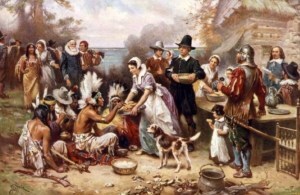 The Wampanoags reached out to the English in Plymouth not because they were friendly but rather because they were decimated by epidemic disease and desperate for help.
The Wampanoags reached out to the English in Plymouth not because they were friendly but rather because they were decimated by epidemic disease and desperate for help.
November 28, 2024
Hurrah for the Pumpkin Pie!
Kate Flora: Bit of holiday whimsy for you today. A Thanksgiving short story

I had exactly thirty minutes to buy everything I needed to cook dinner for twenty, so naturally, navigating the store was like playing bumper cars. As I snatched items off the shelves and shoved my overloaded shopping cart past two tarted-up moms blocking the aisle while they consoled about hair color gone wrong, their sleek heads bobbing and voices cooing like pigeons in the park, that famous line from Tolstoy popped into my head: Happy families are all alike; every unhappy family is unhappy in its own way. I don’t know anything about happy families, but I know plenty about unhappy ones, and one thing I’m certain about is that holidays bring out the worse in mine. In them and in me.
I didn’t even need to be there to script the whole thing. It was consistent every year. Mom and Dad would arrive together but not speaking. She would bustle, tight-lipped, into the kitchen and proceed to get in my way, while Dad would pop his first beer and sit down on the couch to watch football. Baby brother Jesse, who’s living with us since he lost his job, would already be on the other end of the couch, and his silent, cadaver-white girlfriend, Alyse, whose life work is either sleeping or painting her nails black, would be sitting at his feet. Next to arrive would be the “successful brother,” Jared, with his wife Molly and their three barely housebroken children, followed shortly by my oldest brother Jason, his wife Sheryl, and their two hostile teenagers.
Molly and Sheryl would come into the kitchen and unload their offerings onto the counter. Molly’s was always, and only, wine, and her first helpful act would be to open a bottle and pour a glass for herself without offering one to anyone else. Sheryl was toying with being a vegetarian, and she’d take up much of my small counter space with the containers of her own special food—only enough for herself, of course. As dinner grew imminent, with a loopy smile and a “you don’t mind, do you?” she’d move in and start her own personal prep, ignoring the fact that I was making gravy, cooking the peas, and mashing potatoes on the crowded stovetop.
By then I would have asked Sheryl if she’d have Ariel and Jonah set the table, a request she’d blithely ignore, so I’d be rushing back and forth trying to do that while not cooking the peas to mush, occasionally tripping over mom, who liked to stand in the middle of the room, muttering darkly about my dad.
When my husband Charlie got back from hunting with his Uncle Bob and our widowed neighbor, Tom, they’d sit down in front of the TV, too, and send one of the kids out for more beer. When I’d holler to Charlie to come take the turkey from the oven, he’d pretend not to hear me because he was tired from four hours of hunting, and anyway, a working man deserved not to be disturbed. Bob and Tom were both deaf as posts, so they really didn’t hear anything, and my brothers think my poor husband is henpecked, so they’d stay put in a gesture of solidarity.
When I would finally give up and drag the turkey from the oven, I’d find the space I’d cleared for it on the counter now was occupied by two six-packs, and I’d have to stand there, all five foot nothing of me, holding a steaming twenty-four-pound turkey. I’d holler for someone to come and move the beer. If I got lucky, Mom would stop her muttering long enough to do that; otherwise, I’d be yelling until someone in the other room finally gave up and came to my aid. More likely than not, it would be Jared and Molly’s six-year-old, Annie, the most civilized person in the whole lot.
Charlie and I had no kids, and therefore, according to family reasoning, I had fewer demands on my time, which was why everyone thought it was such a great idea for us to host the holiday dinner. Of course, I worked full time, while Sheryl had a part-time job and Molly was a homemaker, but no one seemed to think that counted for anything.
Okay. Yeah. I know. Ann Landers says that nobody can make you do anything that you don’t want to do. All I can say in response is: Ann Landers must have never met my family. As the only girl with all those brothers, I’ve been expected to wait on guys almost since I could crawl. My mom was no different, which may be why she’s gone all weird now. With her, except when she bickers with my dad, it’s like someone’s turned her dial to somewhere between two stations and she’s so busy trying to make sense out of the noises in her head she can’t hear anything that’s happening out here.
Maybe if Charlie were on my side, that might help. I’d met him because he was Jonah’s best friend. I should have known better but at the time, I was running on hormones and not good sense and so I married him. I was knocked up when we got married, which I’ve never heard the end of, never mind that Molly and Sheryl both were, too, but I lost that baby and have never gotten pregnant since. And now here I was running through the grocery store like buying food was a 5K, when I’d sworn that last year was going to be the last time I let them do this to me.
The simple fact was that I couldn’t get anyone to listen. I’d planned it all out. Sometime around September, I’d talk with my sisters-in-law, everyone would get assignments, and we’d share the work. But even though I’d done that, and they’d all nodded and agreed, last week when I called to make sure they remembered their jobs, they’d all somehow forgotten and were just too busy add it to their schedules now. They said they were sorry.
Well, I was too busy to add it to my schedule, too, but look where I was. Back in the grocery store, making a martyr of myself because I couldn’t think how to do it differently. Maybe if I just burned the whole dinner? Or forgot to make the dressing? I’d never hear the end of that, but they were all such lazy slugs that they’d be bound to want to give me a second chance. A chance I did not want.
Once I’d loaded it all into my car, I headed for home, and it’s when I passed the CVS that I got the great idea. Everyone in my family, except the little kids, is big on stuffing. Or dressing, as my husband’s family calls it. I don’t eat it, but they’re so passionate about the stuff that they call me days ahead of time to remind me to be sure and make enough. These are the same people, mind you, who can’t find the time to do anything to help, but they’ve always got time to remind me about the dressing, which has to have cornbread and oysters. That and the pumpkin pie. There’s got to be pumpkin. And apple. And pecan. And Uncle Tom doesn’t think it’s a holiday unless there’s mincemeat. And me working late every night because we’re going into the holiday season.
I was so tired I was about in tears, trying to figure out how I’d do it all, when I passed that CVS. And it must have been the devil on my shoulder, whispering in my ear, because I found my car turning right into the parking lot and next thing you know, I was coming out with a couple family-sized packages of laxatives. They’d crush up nice in my mortar and pestle, and mix just fine in the dressing and the pumpkin pie. The way everyone gobbled, no one would notice a thing. Hopefully not until they were safely home.
I stared into my car, at all the bags of food awaiting my attention, but now I felt different. I still had a lot of work ahead of me, but for the first time in a long while, I had found my smile.
“Happy Thanksgiving,” I whispered, as I headed for home. Good thing I’d thought to buy extra toilet paper.
November 27, 2024
Introducing Gabriela Stiteler
 Today we’re delighted to introduce Gabi Stiteler, who is joining our blogging team. She’s a dynamo, as those who know her can attest. Gabi moves at the speed of light, doing great work for the crime writing community. We’re excited to read her posts.
Today we’re delighted to introduce Gabi Stiteler, who is joining our blogging team. She’s a dynamo, as those who know her can attest. Gabi moves at the speed of light, doing great work for the crime writing community. We’re excited to read her posts.
Tell us a little about yourself? What’s your background? Are you a native Mainer? If not, how did you end up in Portland, Maine?
I was born in Pittsburgh and grew up in Northeastern PA and married into Maine. My husband’s grandparents lived in Eastport. When we had kids, we knew Maine was where we wanted to end up. We landed in Portland and love it. We live on a dead end street a few blocks from the water, the kids run around with neighborhood kids playing baseball and basketball and soccer. It’s a bonus that my mother-in-law is an amazing elementary school teacher and her husband is a retired homebuilder. They take the kids for weeks at a stretch and have helped us fix up our house. (It had been vacant for a stretch when we bought it and has needed a little TLC.)
What are your favorite things about Portland?
It’s a great place for us to raise our kids, geographically beautiful, and has an amazing arts scene. I can put a plug in for my neighborhood in particular – we have some great restaurants like Tipo and Woodfords and the Great Lost Bear, and amazing local bookstore, Backcove Books, a great coffee place at Coveside Coffee. Payson Park is always filled with activities from little league to frisbee golf to sword-fighting. And, we have a pretty great neighborhood ice cream place in Sammy Scoops. I’ve also met so many other writers and people in the writing community who go out of their way to be supportive.
Now, turning to crime writing. You’ve had the amazing accomplishment of having your very first submitted story published by Ellery Queen Mystery Magazine. Tell us about that story, and about how it felt to have it chosen for publication.
So I’ll start with the caveat that I have three manuscripts collecting dust in my desk drawer. Going nowhere.
My luck with short stories has been a little different. I went to Crime Bake in 2022 and was inspired to write a short story on the Downeaster from Boston to Portland. It was about a widowed woman who goes back to her home town to help an old friend who’s been arrested for matricide. (You can actually read the full story here or listen to it here.)
I put it down for a week, looked at it again, and it held up. I sent it to a writer friend who said, “Immediately submit this to Ellery Queen.” Which I did, knowing very little about short story publications. That was in January. By March, Janet Hutchings, the Editor of EQ, purchased it for the Department of First Stories. It made it to print in the September/October edition 2023 and ended up being nominated for the MWA Robert L. Fish Award at the 2024 Edgars. (The Fish Award goes to the best crime story by a first-time writer.) It also made it into the Other Distinguished category for the Best Mystery and Suspense of 2023.
All of which is a little bananas.
What has your publication success been like since then?
I’ve experienced a bit of success since. My short stories have been accepted by publications that include Alfred Hitchcock and Ellery Queen. I’ve also found homes for stories in anthologies like The Best of NE Crime Writing, At the Edge of Darkness: Shotgun Honey Anthology, and Dark Waters (volume 2).
I’ve learned a lot about the process. Different publications move at different speeds. For example, Alfred Hitchcock took over a year to review each of the stories I submitted, which I understand to be pretty normal for the publication. Ellery Queen is usually a little faster. Rejections come more quickly than acceptances. All three of my Ellery Queen acceptances have come between 3 and 4 months.
After a story is purchased, it can take another year for the story to make it to print. For example, I submitted a story to Alfred Hitchcock in March of 2023. Linda Landrigan got back to me in August of 2024 to purchase it. I just learned that it will come out in the March/April Ed for 2025. So that’s two years out from when I originally submitted the story.
So far, you’ve published numerous short stories. One might say you are a short story queen. Do you plan to publish long works as well? Are you working on something?
I’m definitely experiencing a lot of luck with my short stories. But royalty? Stephen Rogers, the MWA NE Chapter president has over 800 short stories floating around. And there’s Barb Goffman. And Michael Bracken. And, you know, Joyce Carol Oates.
I have a notebook full of ideas for longer stories, but am living life in little bites right now because of my work schedule and my children.
As for what I’m working on right now? I have this brilliant idea to work my way through all of the classic tropes of crime writing. Noir. Procedural. PI. Sherlockian. Locked door. Cozy. Historical. Domestic suspense. Thriller. Traditional. You name it and I want to try it. It’s like a love letter to the genre.
Accepted but not published: AHMM has a story called “Quick Turnaround” about a “fixer” who becomes obsessed with a missing woman – out in March 2025. EQMM has two stories. “The Usual Reasons” is with Annie, the widowed divorce attorney from my first story. When her younger sister’s deadbeat ex discovers his uncle’s corpse, Annie reluctantly agrees to look into things. “A Hard Nights Sleep” is about a woman grappling with her husband’s cognitive decline. It explores parental love and, of course, murder.
On Submission: I have a little league story out that I think is pretty good. And I tried a PI story. I’m cautiously optimistic about both.
Done but Waiting: I have another PI story done because the first one was so much fun. I’m just waiting to see how things go before I send it out into the world. I also finished this creepy story about two brothers. It’s really disturbing and I don’t know what I’m doing with it yet.
In Progress: I’m working on another story with Annie, the widowed divorce attorney from my first story. It’s her third story. And I have the outline for a locked door story that takes place on a small Maine island that I’d like to be from the POV of a 14-year-old girl.
Can’t turn this brain off, you know.
You’ve been very involved in the mystery community—the Maine Crime Wave, Sisters in Crime, the New England Crime Bake. What’s that like? Is it true that crime writers really are a community, and a welcoming one?
YES! When I wrote that first manuscript and sent it out into the world, I sent emails to some of my favorite mystery writers, who all wrote back and gave me some variation of the same advice. Start working on your next project and join some writing groups.
I absolutely love the NE crime writing community. I’ve made some amazing friends and have a community of people who cheer me on and celebrate with me.
If you are a Maine-based crime writer, or aspiring writer of any kind, I’d recommend looking into Sisters in Crime and the Maine Writers and Publishers Alliance if you haven’t already. Both organizations offer excellent programming and support to writers at any stage in the journey.
For short stories – The Short Mystery Fiction Society Blog is a great resource. You can learn more here. Membership is free and experienced writers share tidbits of wisdom, publication news, and submission details.
As for conferences – Crime Wave and Crime Bake are two wonderful conferences. They’re great ways to meet other writers, agents, and editors. And both conferences are focused on keeping prices affordable, which I appreciate. There are a lot of other great conferences out there, but by the time you factor in travel and hotels, they can get pretty expensive. And I have two kids and tight budget, so both Crime Bake and Crime Wave are great options for me to stay connected and meet people while staying within what I can afford.
The advice to aspiring writers has often been either don’t quit your day job or marry someone with benefits. Do you have a day job?
For the sake of full transparency: I’ve sold 9 stories, ranging in words from 1,500 to 7,500. 4 have gone to publications that pay professional rates of 5-8 cents a word. One sale was to a podcast for $30.00. And the other 4 have gone to anthologies that paid $25.00 a story. So my total revenue this year works out to be around $1,540.00.
So unless you are independently wealthy (I am not), I’d say don’t quit your day job.
And a family? My mother used to get up at 4:30 in the morning for some quiet writing time. How do you find the time to write?
My work schedule is very irregular. Sometimes I’m facilitating meetings at night. Sometimes I leave at 4 in the morning to drive to Connecticut or midcoast for a meeting. And my kids are really active with sports. So afternoons and evenings my husband and I tag team soccer or cross country or baseball or basketball.
So when do I have time to write?
My current routine is writing weekdays in the evening from 8:30-9:30. On the weekends I can write from 7:00-10:00 in the morning. My husband and kids are pretty good about giving me time and space.
My process?
I do a lot of my plotting when I drive, or when I’m sitting at a little league game watching the kids play or when I’m out for a walk. I like to really mull over stories for a while.
Then I start writing in a notebook. Sometimes I sketch out the whole story. Sometimes I just need the first few scenes. Writing by hand really helps me get a better sense for the characters and feeling of a story. But once I have a sense for it? I can usually move pretty quickly and knock out the full story within a few hours.
After I type out the draft and work through it a little, I’ll record it and then go for a walk and listen to get a sense for what works and what doesn’t. I usually share it with a friend or two for big picture feedback. Then I send it out into the world.
As for advice?
Find your community.
Put your work out there.
Ask questions and listen. Take what you need.
And keep writing.
Bio
Gabriela Stiteler is a writer based in Portland, Maine where she lives with her husband, children, and rescue lab. Gabi grew up in Northwestern Pennsylvania on a steady diet of paperback books from the Golden Age of Detective fiction, classic noir films, and Spaghetti Westerns. She’s especially partial to classic tropes reimagined and twisty plots. Lately she’s been thinking about how bad a person can be before they’re irredeemable.
Gabi’s debut short story “Two Hours West of Nothing” was nominated for the Robert L. Fish Award and was an Other Distinguished Mystery and Suspense for the Best American Mystery and Suspense (2024). Her writing has since found homes in publications that include: Ellery Queen Mystery Magazine, Alfred Hitchcock Mystery Magazine, The Best of New England Crime Writing, Dark Waters (volume 2) and Shotgun Honey Presents.
In her free time, she explores the coastline, walks her dog, and learns to do new things with varying levels of success.
Website : https://www.gabrielastiteler.com
November 25, 2024
Help . . .
OK, we’ve had some time to digest the fact that half the country doesn’t care about a President-elect’s sexual rapacity, his kooky economic ideas, his gibbering speech style, his racism and misogyny, and the likelihood he’s kissing up to one of our chief enemies in the world, as much as they care about the stock market going up and Brown people going away. If you’re thunderstruck by how badly you misread so many of your fellow citizens, join the club.
I’m going to take a long dangerous step into the quicksand—I don’t love talking politics—and ask the question that I hope is on everyone’s mind. I know it’s on mine. What the hell do we do now? Because here we are:
“. . .America is sliding back into the Middle Ages, as white supremacy exerts itself not only over Black bodies, but over women’s bodies too. False narratives rooted in antiquated religiosity and bigoted ideas from hundreds of years ago are used to justify this, and find willing audiences and believers.” Salman Rushdie (Knife)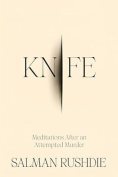
So: can crime fiction matter in the current state? Are we only entertainers? Or is there space for us to resist things we don’t believe in? Is there still a relevance for us? Or are we still bound by our conventions to (only) “tell a good story,” to fill time for our readers without challenging them?
Fiction has a long history of social commentary. Think Dickens exposing child labor in London, Steinbeck the plight of migrant workers, Upton Sinclair the perils of letting the profit motive drive your food system.
I’d like to read more books like Razorblade Tears (Sean Cosby)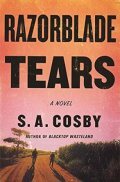 , where two fathers, one black and one white, team up to avenge the murders of their gay sons. It deals directly, but through character and story, with racism and anti gay violence. A book like this gives me hope we can find more ways to resist. C.J. Box, whose books treat political and cultural issues in the American West, is another writer I see working this way.
, where two fathers, one black and one white, team up to avenge the murders of their gay sons. It deals directly, but through character and story, with racism and anti gay violence. A book like this gives me hope we can find more ways to resist. C.J. Box, whose books treat political and cultural issues in the American West, is another writer I see working this way.
We need to write these books because the media we’ve relied on in the past, the major metropolitan newspapers, the television and cable pundits, have failed us utterly. Like Upton Sinclair’s meatpackers, they have abandoned all standards of honesty for the sake of profit and relevance. I want more writers and more books that grapple with the factual world, fewer fancies where the violence is cartoonish and the good guys mostly win.
Less fluff, less diversion, more meat. I know these writers are out there. Let’s find them and celebrate them. I’d venture to say crime fiction has a larger audience than what the gatekeepers call “literary” fiction. Drop your suggestions in the comments, please. Help a demoralized writer out.
Gratitude and Thankfulness
This Thursday is Thanksgiving Day in the United States. A day to dine with family and friends, look back on the past year, and count our blessings. There’s no denying that we’ve been through a stressful 2024. One that’s made us search for things that bring us peace. It’s always been my practice to turn to nature during troubled times. I’m lucky to live in Maine. A state where beauty is right outside my dooryard. I’d like to share some of my happy places with you and wish you a happy Thanksgiving.

Woods in fall

A colorful corner

At the trailhead

Family Passing Through

Deer herd in the yard

The start of a winter morning
November 22, 2024
Weekend Update: November 23-24, 2024
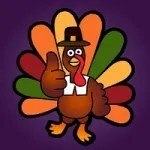 Next week at Maine Crime Writers there will be posts by Kait Carson (Monday), Dick Cass (Tuesday), and Charlene D’Avanzo (Friday), and on Wednesday we’ll be introducing you to new Maine Crime Writers’ regular, Gabi Stiteler.
Next week at Maine Crime Writers there will be posts by Kait Carson (Monday), Dick Cass (Tuesday), and Charlene D’Avanzo (Friday), and on Wednesday we’ll be introducing you to new Maine Crime Writers’ regular, Gabi Stiteler.
In the news department, here’s what’s happening with some of us who blog regularly at Maine Crime Writers:
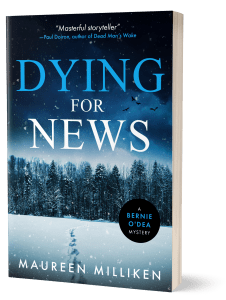 Maureen Milliken will be at Letterpress Books & Gifts, 91 Auburn St., Portland from 11 a.m. to 1 p.m. today (Saturday, Nov. 23), for a meet and greet. Stop in to say hi, pick up a signed copy of her latest Bernadette “Bernie” O’Dea mystery series, DYING FOR NEWS, and check out the book store!
Maureen Milliken will be at Letterpress Books & Gifts, 91 Auburn St., Portland from 11 a.m. to 1 p.m. today (Saturday, Nov. 23), for a meet and greet. Stop in to say hi, pick up a signed copy of her latest Bernadette “Bernie” O’Dea mystery series, DYING FOR NEWS, and check out the book store!
On Tuesday, Nov. 26, Maureen will join mystery writers DonnaRae Menard and Elaine Isaak (EC Ambrose) for a panel on “Where Writers Get Their Inspiration,” at 6 p.m. at Meredith Public Library, 91 Main St., Meredith, New Hampshire.
Check out Maureen’s website, maureenmilliken.com, for more upcoming events and other updates on her latest book, DYING FOR NEWS.
An invitation to readers of this blog: Do you have news relating to Maine, Crime, or Writing? We’d love to hear from you. Just comment below to share.
And a reminder: If your library, school, or organization is looking for a speaker, we are often available to talk about the writing process, research, where we get our ideas, and other mysteries of the business, along with the very popular “Making a Mystery” with audience participation, and “Casting Call: How We Staff Our Mysteries.” We also do programs on Zoom. Contact Kate Flora
November 21, 2024
Fiction and Truth. Together? Not An Oxymoron.
Sandra Neily here:
“Since we cannot expect truth from our institutions, we must expect it from our writers.” Edward Abbey, quoted in my 2018 post, reprinted below.
(OK. Here goes. Trump is the only president to have removed more protections from U.S. lands and waters than he put in place. He removed 35 million acres of public lands and ocean preserves. President Biden, with legal help from dedicated organizations’ legal teams, restored most of it. Below, I share links to those organizations.)
Here I reprint (with a few edits) most of a 2018 post that I think, might be a good current read. I have elevated Abbey’s ending quote into a headline.
****************
Fiction and Truth. Not An Oxymoron
It’s a mystery to me why essayist Ralph Waldo Emerson wrote these lines: “Fiction reveals truth that reality obscures.” I’m just grateful that he did. These words are my writing mantra.
My fiction is based on an early truth I learned growing up in East Boothbay, Maine.

Damariscotta River, East Boothbay. “Our” island.
I learned that the natural world is a disappearing world.
At age six, I saw bulldozers dump fill to bury my sandbar and island to create boat storage. Not my island and not the shipyard’s either, but it was our sibling sanctuary, our pallet for adventure, and our home away from home. (We quickly learned to read tide charts my mother never mastered so we’d be “stuck” on the island as she paced the far shore. A fine way to avoid naps.)

The shipyard begins to bury the island to create more land for boat storage. It filled the cove all the way to the island.
Over the years, the wild woods and waters around me disappeared under bulldozers or behind gated driveways. These losses are my fiction’s marrow.
My seriously unsupervised childhood grew into a career deeply engaged with our woods, waters, and wildlife assets. I’ve been a whitewater river outfitter, a licensed Maine Guide, founder of a coalition to protect Maine’s Penobscot River from a destructive dam, and the director of a conservation school. Working for Maine Audubon, I researched and authored “Valuing the Nature of Maine,” and ‘Watching Out for Maine’s Wildlife,” (reports revealing the money and jobs intact resources produce.)
I’ve penned op-eds, legislative testimony, articles, and newsletters for receptive audiences, but no more. Far too often people select reading material and media that reflect their own preferences and life stories. They are trapped in narrow, information silos that isolate them from the knowledge and compassion we need to secure a future for the natural world.

Headwaters of the Kennebec River. Protected.
And because not enough folks from all walks of life have found Rachel Carson’s Silent Spring and they aren’t reading Terry Tempest Williams, Rick Bass, Wendell Berry, or even braving Elizabeth Kolbert’s excellent The Sixth Extinction, I decided to leave non-fiction and write murder mysteries. I wanted to pile up bodies, and clues, and sleuths and have them all inhabit special landscapes that could spawn a murder or ultimately solve one.

Moosehead Lake seen from Maine Public Lands “Moose Mt.” Unit. Protected.
I chose the mystery genre to captivate and entertain readers, but of course I hope to seduce them toward the outdoors and have them discover some truths that “reality obscures.” My novels dive into the heart of Maine’s outdoors, its vibrant wildlife, and the reality of what’s lost or at risk.

A favorite ‘protected ‘corner of the world with favorite friends.
When I am invited to speak, I suggest that authors who create nature-themed fiction might be true and trusted voices in the wilderness of modern life, helping us savor what is unknown or ignored or unappreciated. If writers help us fall in love with or marvel at a corner of the world, even as they pull us from page to page with their skill, we are already signed up to care about that corner of the world.
To share some of my favorite authors, I bring the audience a handout of quotes and reviews. Here’s some of what I share. (The full version’s on my website.)
“A choir of seedlings arching their necks out of rotted tree stumps, sucking life out of death. I am the forest’s conscience, but remember, the forest eats itself and lives forever.” Barbara Kingsolver, The Poisonwood Bible
“The sigh of all the seas breaking in measure round the isles soothed them; the night wrapped them; nothing broke their sleep, until, the birds beginning and the dawn weaving their thin voices in to its whiteness.” Virginia Woolf, To the Lighthouse
“The clouds were building up now for the trade wind and he looked ahead and saw a flight of wild ducks etching themselves against the sky over the water, then blurring, then etching again and he knew no man was ever alone on the sea.” 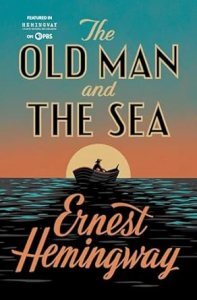 Ernest Hemingway, The Old Man and the Sea
Ernest Hemingway, The Old Man and the Sea
“As I looked about me I felt that the grass was the country, as the water is the sea. The red of the grass made all the great prairie the colour of wine stains, or of certain seaweeds when they are first washed up. And there was so much motion in it; the whole country seemed, somehow, to be running.” Willa Cather, My Ántonia
“When he says ‘Skins or blankets?’ it will take you a moment to realized that he’s asking which you want to sleep under. And in your hesitation he’ll decide that he wants to see your skin wrapped in the big black moose hide. He carried it, he’ll say, soaking wet and heavier than a dead man, across the tundra for two—was it hours or days or weeks? It’s December, and your skin is never really warm, so you will pull the bulk of it around you and pose for him, pose for his camera, without having to narrate this moose’s death.” Pam Houston, Cowboys Are My Weakness
Here are more voices bringing the natural world to us: Heat and Light, Jennifer Haigh. Breaking Point, C.J. Box. Winter Study, Nevada Barr. 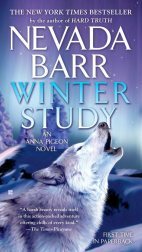 The Nature of the Beast, Louise Penny. Massacre Pond, Paul Doiron. The Weight of Winter, Cathie Pelletier. Skinny Dip, Carl Hiaasen. The Secret Wisdom of the Earth, Christopher Scotton. The Monkey Wrench Gang, Edward Abbey.
The Nature of the Beast, Louise Penny. Massacre Pond, Paul Doiron. The Weight of Winter, Cathie Pelletier. Skinny Dip, Carl Hiaasen. The Secret Wisdom of the Earth, Christopher Scotton. The Monkey Wrench Gang, Edward Abbey.
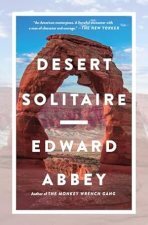 Today, when truth is under relentless assault, perhaps Ed Abbey … again … should have the last word. “Since we cannot expect truth from our institutions, we must expect it from our writers.”
Today, when truth is under relentless assault, perhaps Ed Abbey … again … should have the last word. “Since we cannot expect truth from our institutions, we must expect it from our writers.”
***********
Join Up. The last time we experienced an anti-environmental administration, I joined the Sierra Club the day after the election. I’m glad I did. During those tough four years The Sierra Club, the Natural Resources Defense Council and the Wilderness Society shouldered huge costs and burdens fighting legal and institutional battles needed to protect our woods, prairies, wildlands, waters, wildlife assets and most significantly, our public lands. They accomplished miracles. They know what’s coming. They are gearing up. They need our help. I invite you to copy this info and share it with your own networks and friends. Maybe after you join up. (I renewed my Sierra Club membership on November 6th.)
Sandy’s debut novel, “Deadly Trespass, A Mystery in Maine” won a national Mystery Writers of America award, was a finalist in the Women’s Fiction Writers Association “Rising Star” contest, and was a finalist for a Maine Literary Award. 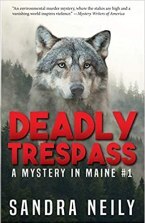 The second Mystery in Maine, “Deadly Turn,” was published in 2021. Her third “Deadly” is due out in 2025. Find her novels at all Shermans Books (Maine) and on Amazon. Find more info on Sandy’s website.
The second Mystery in Maine, “Deadly Turn,” was published in 2021. Her third “Deadly” is due out in 2025. Find her novels at all Shermans Books (Maine) and on Amazon. Find more info on Sandy’s website.
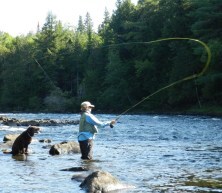
Another protected (but secret) place.
November 20, 2024
Turning the table: Questions for Maine mystery readers
As I meet and talk to readers at signings and other events, it’s always a pleasure to listen to their opinions and questions about my Bernadette “Bernie” O’Dea mystery series. I welcome questions about my choices, why characters do certain things, or why the plot took a turn it did.
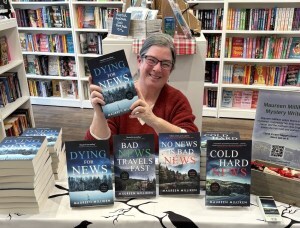
Ready to talk to readers at Oliver & Friends Bookshop in Waterville Nov. 16.
Many readers I’ve talked to recently — a surprising number — have expressed hope and opinions about what they want to see happen to my main characters in the latest book, DYING FOR NEWS, which came out in October. I don’t want to spoil the book for people who haven’t read it, so I don’t give a lot away as I ease them past the questions. [Some who have already read it also have some strong opinions, but that’s a blog post for a day when the book has been out for a while].
Readers’ strong opinions, suggestions and hopes for characters and plotlines also prompt me to ask questions of them. At my most recent event, a very lively book signing at Oliver & Friends Bookshop, in Waterville, I was lucky enough to talk to readers who’d read the first three books in the series and couldn’t wait to get their hands on the fourth. They had some very strong opinions about the books they’d already read. They had questions. And I had just as many questions for them.
As I drove home, it occurred to me that it was time to turn the tables. Instead of a post telling readers what I think, I’ll give readers the opportunity to think about how they read and react to books without having to hear my two cents about it.
Don’t send me your answers! These are questions you can ask yourself as you read any book, not just mine. They may increase your enjoyment of the book, and even give you some ammo if you run into the author at an event or in the grocery store.
Here we go:
Are you willing to stick with a character you like when they do something that bothers or frustrates you? Why do you think the author had the character do those annoying things?
Instead of wondering who the author has in mind to play the characters in a movie, who who do YOU think would play them?
How much of a role does the setting play in the story? Could this book have been set somewhere else and still have the same results or impact?
How much of an impact does the book have on your emotions (aside frustration at a character) — did it make you laugh or cry? Both?
Does the book make you think more about things in the real world than you otherwise would have, or see anything differently?
If you liked the book, and were to meet the author, what would you tell her, specifically, about what you liked?
There are no wrong answers to these questions. You don’t even have to answer them, or even think about them, if you don’t want to. But if you really like a book, don’t be afraid to drop the author a line, or track her or him down at an event, and give them your thoughts. Authors love to to talk to readers who have read their book and want to discuss it.
Lea Wait's Blog
- Lea Wait's profile
- 508 followers



